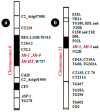Tomato Natural Resistance Genes in Controlling the Root-Knot Nematode
- PMID: 31739481
- PMCID: PMC6896013
- DOI: 10.3390/genes10110925
Tomato Natural Resistance Genes in Controlling the Root-Knot Nematode
Abstract
The root-knot nematode (RKN) is one of the most dangerous and widespread types of nematodes affecting tomatoes. There are few methods for controlling nematodes in tomatoes. Nature resistance genes (R-genes) are important in conferring resistance against nematodes. These genes that confer resistance to the RKN have already been identified as Mi-1, Mi-2, Mi-3, Mi-4, Mi-5, Mi-6, Mi-7, Mi-8, Mi-9, and Mi-HT. Only five of these genes have been mapped. The major problem is that their resistance breaks down at high temperatures. Some of these genes still work at high temperatures. In this paper, the mechanism and characteristics of these natural resistance genes are summarized. Other difficulties in using these genes in the resistance and how to improve them are also mentioned.
Keywords: Mi resistance genes; gene-based marker; heat-stable resistance; root-knot nematode; tomato-resistant resources.
Conflict of interest statement
The authors have no conflicts of interest to report.
Figures





References
-
- Neal J.C. The Root-Knot Disease of the Peach, Orange, and Other Plants in Florida due to the Work of Anguillula. U.S. Dept. of Agriculture, Division of Entomology; Washington, DC, USA: 1889.
-
- Seebold K.W. Root-Knot Nematode in Commercial & Residential Crops. College of Agriculture, University of Kentucky; Lexington, KY, USA: 2014. Plant Pathology Fact Sheet; Plant Pathology Extension. PPFS-GEN-10.
-
- Bailey D.M. The seedling test method for root-knot nematode resistance. Proc. Am. Soc. Hortic. Sci. 1941;38:573–575.
Publication types
MeSH terms
Substances
LinkOut - more resources
Full Text Sources
Other Literature Sources

